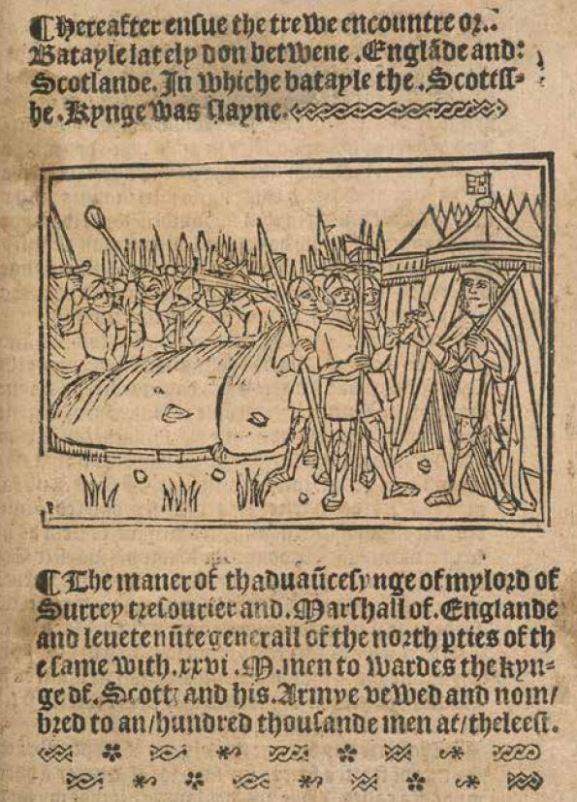
Here’s some breaking news for you…
On 22 April, and running until 21 August 2022, the British Library will be hosting a major exhibition on the history of news in Britain. Entitled Breaking the News, it will (according to the press release) spotlight the role news plays in our society, exploring issues of choice, interpretation, truth and trust in the news.
The exhibition will be covering over 500 years of news in this country, from the earliest surviving printed news publication in the Library holds – a pamphlet hot from the scene of the Battle of Flodden, 1513 – to the news of today in its multifarious forms. There will be newspapers, news sheets, news pamphlets, newsbooks, broadsides, prints, cartoons, newsreels, radio news, television news, websites, social media, pushing at the boundaries of what might expect to find in an exhibition while presenting the broadest of interpretations of just what news is.
The exhibition is to be based around stories, abandoning chronology and placing the audience experience of news over the traditional way of documenting news history, which has been from the perspective of its usual producers, the news media. The stories will be organised around questions such as what makes an event news, what a free press means, the ethics involved in making the news, and what objective news might mean. It’s underlying question will be, who owns the news? Is it them or is it us, and if the latter, then what is our role?
Well, that’s ambitious.
I’m what’s called the lead curator for this exhibition, whatever that might mean. I’ve been working on it since 2014, when I first thought it might be a good idea were we to have an exhibition to mark the 400th anniversary of the first newspaper to be published in Britain, a date that fell in 1621 (as with all ‘firsts’, there are plenty of reasons to qualify such a statement, but not just now). Time and Covid put paid to that dream, so that we’re now hosting the exhibition that opens seven months later and says that we’re celebrating 500 years of news in Britain. Or thereabouts.

A major exhibition starts off being one person’s idea, but ends up being adopted by the entire institution. This is not just because so many people need to be involved – from curators, to organisers, to designers, to marketing folk, to conservationists, to fundraisers, to box office people, to lawyers, to publishers, and so on – but also because such an exhibition is as much about the institution as it is about the subject chosen. No major exhibition is put on arbitrarily. It must reflect the mission of the institution, what it needs to be seen to be reflecting. It can be based around that institution’s own collections, though not inevitably so. It exemplifies that which the institution has to offer to society.
All of this is inevitable, and good. It also induces much anxiety, as you worry about everything from whether you have represented your topic properly to whether anyone will want to pay to see it. Some exhibitions have a natural logic to them, such as museums or art galleries put on, since they are filled with things designed to be stared at – statues, pots, paintings, artefacts – in perpetuity. With the news, you are dealing with something designed to be consumed then thrown away, because the next news item is on its way, consigning the previous one to history. It is a profoundly mobile mass-medium: always tied to the moment, always tracking us through present time.
That’s why it’s a good idea (we hope) to present a news exhibition through stories, because the beauty of historical news is the moment you start reading it (or listening to it, or viewing it), then it becomes news again. The names become characters, the situations become dilemmas, the lessons become real. We want to know what happened next. There are few more powerful ways of making an emotional connection with the past than reading an historical newspaper. Once again, we are there. Once again, the news is mobile.
News is a challenging topic for an exhibition, nonetheless. It’s a topic on which everyone has reason to feel that they are an expert, but of course those opinions differ and often contradict the opinions of others. There is no way of getting news right. Instead all you can do is offer an environment in which an intelligent view might be formed, one that encourages questions and delights in reasoned debate. And that, of course, is the mission of a place such as the British Library.
Reason through discovery. QED.
Links:
- Breaking the News opening to the public on 22 April 2021 and runs to 21 August at the British Library’s St Pancras site in London. There will also be a touring version at over thirty public libraries across the UK, all part of what is called the Living Knowledge Network, opening on 24 February. There is more information on the British Library press release for its Spring/Summer 2022 exhibition programme. The page for bookings is here: https://www.bl.uk/events/breaking-the-news
- The exhibition will be accompanied by a book, also called Breaking the News, edited by Jackie Harrison and myself, with contributions from a notable line-up of historians, journalists and curators. It will be available from when the exhibition opens in April 2022
- The Flodden pamphlet and the Guardian‘s pulverized computer parts will both feature in the London exhibition